After more than 20 years of waiting, communities in the highlands of Guatemala are finally able to bury their loved ones—victims of some of the most brutal violence of the country's 36-year civil war. After an arduous process of gathering testimonies, finding the mass graves, and exhuming the bodies, villagers hope the dead will finally be able to rest in peace.
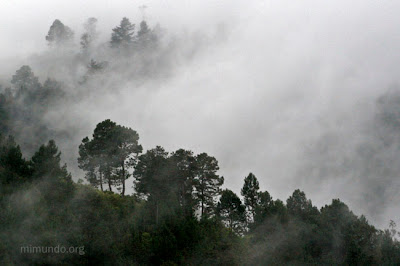
Tucked high among the cloudy summits that slash in half the Department of Quiché, lies the municipality of Chajul. This is the northeastern corner of the so-called Ixil Triangle, whose name derives from the main ethnic group that has populated the region for centuries: the Ixil Maya. During the internal conflict, which brutally pounded Guatemala for 36 years, the population from the Department of Quiché suffered perhaps the roughest punishment. According to the Recuperation of Historic Memory report (known as REMHI in Spanish and titled, Guatemala: Never Again), 263 massacres were perpetrated against residents of Quiché during the conflict.
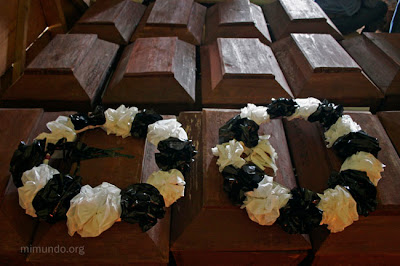
Starting in November 2004, the National Coordination of Widows in Guatemala (CONAVIGUA) began compiling witness testimonies from the villages of Juá, Chel and Xaxmoxan, within the Municipality of Chajul, in order to begin the process of recovering the remains of war victims buried in clandestine graves. The Guatemalan Forensic Anthropology Foundation (FAFG) carried out successful exhumations in the region through most of 2005, resulting in the identified remains of 14 victims.
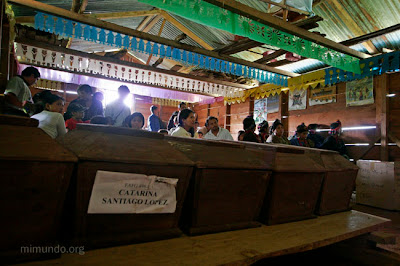
On January 25, 2007, families of the identified victims congregated in Xaxmoxan’s church to receive the remains of their deceased relatives. The victims perished as a result of the State’s brutal genocidal policy that came to be known as the "Scorched Earth" campaign, carried out mostly during the first half of the 1980s.

Feliciana Macario (left), director of CONAVIGUA, addresses the victims’ family members before handing over the remains of the deceased. Entire families from Xaxmoxan, as well as from the neighboring settlements of Juá and Chel, attended the event. The three rural communities are barely divided by a couple of kilometers.
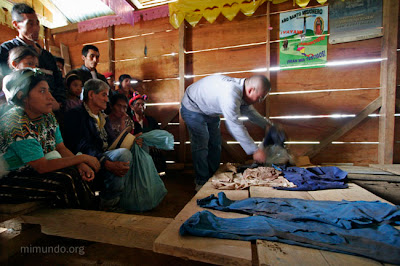
Joseph Fuentes, forensic anthropologist from FAFG, displays some of the clothing found in the clandestine mass graves hoping it will help living family members identify the remains of victims.
A traditional hair-dress ribbon, used by local women, is found still intertwined with human hair. The report from the Historic Clarification Commission (CEH) states, “On March 24, 1982… Soldiers brought residents from Caracolito ranch and Xaxmoxan village [to La Perla ranch, in Juá]. 175 men were executed… Some women and children were also killed, youths in particular. Out of the 250 people who managed to escape from the community [into the wilderness], 25 died due to sickness or malnourishment” (CEH, Chapter II, Part II, pp. 340-1). This is known as La Perla ranch massacre.
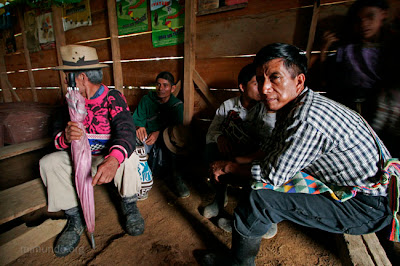
The process of handing over the remains to the appropriate family members lasted a few hours. Nevertheless, the delay was short compared to the years many of them waited to appropriately bury their family members. It is estimated all 14 victims perished between 1980 and 1983. Congruently, the REMHI report identifies five massacres in the vicinity during the same time frame, four in Chel and the La Perla Ranch incident (REMHI, Volume II, p. 42).
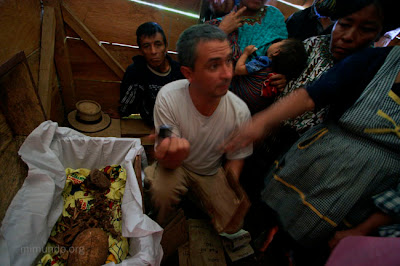
The coffin with the remains of Genara López López is arranged by forensic anthropologist Alejandro Urízar while family members observe.
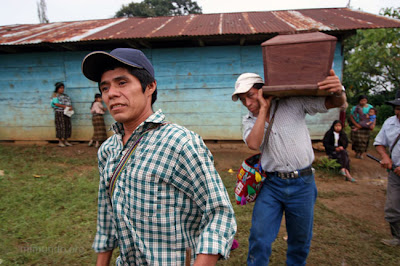
Beltran López (front), son of Genara López López, indicated his mother perished in the nearby town of Chel during the massacre of March 1982. “Thank God she has arrived,” uttered Mr. López.
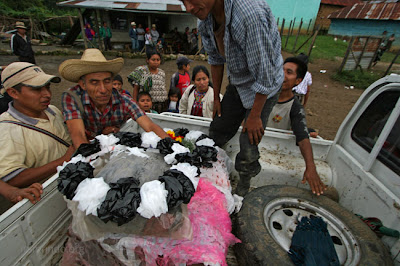
Family members prepare to transport the remains of a victim to a site where a mourning ceremony will take place in the evening.
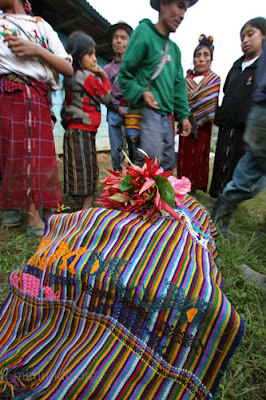
Most of the coffins were decorated with shawls exhibiting patterns similar to the ones worn by the local Ixil women.
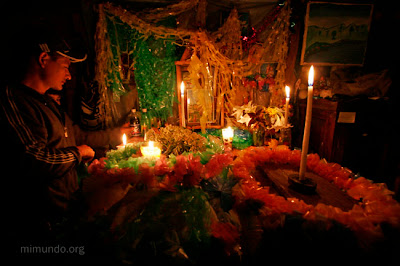
During the evening, several households in the communities of Juá, Chel, and Xaxmoxan held individual mourning ceremonies in memory of the deceased.
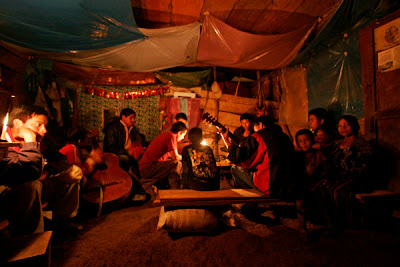
Those who speak another tongue, give them love,
Those who think differently, give them love.
Do not differentiate between race or skin color,
Love everyone like kin and do what’s right.
To eternal friends, give them love,
And to those who don’t bother greeting you, give them love.
—Lyrics sung at one of the mourning ceremonies.
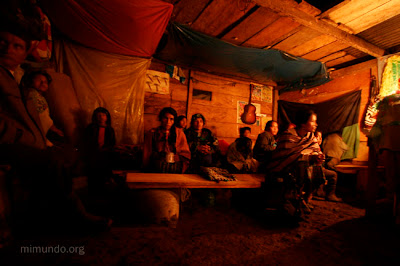
Family members watch and listen from the other side of the room.
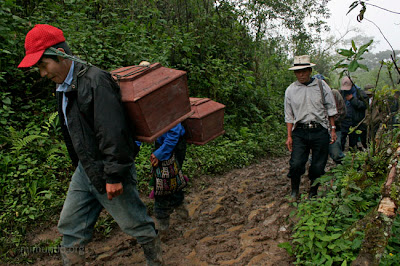
During the early hours of January 26, residents of Xaxmoxan headed towards the community cemetery where, after more than 20 years in waiting, a dignified burial ceremony awaited the war victims.
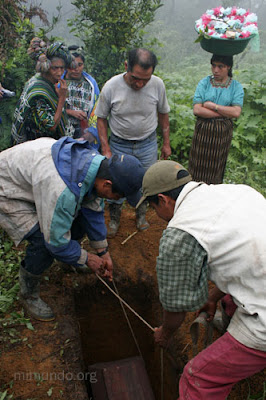
The remains of one of the more than 200,000 victims claimed by Guatemala’s internal conflict are lowered into a final resting place.
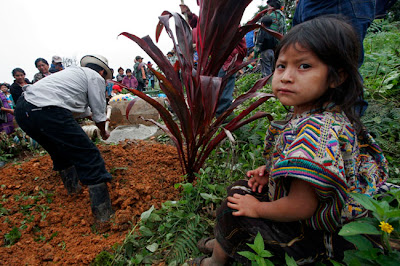
A plant named Rooster’s Tail is planted on top of the gravesite in accordance with Ixil Mayan traditions.
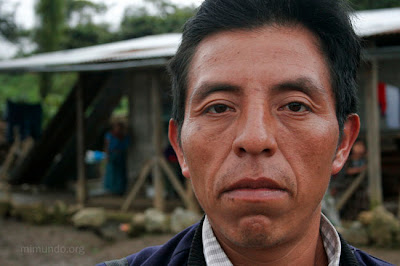
Juan Francisco Pedro’s father, Ramon Francisco Bautista, is documented as victim case number 3284 in the CEH report. The text states, “In 1983, amongst the mountains nearby the Los Encuentros comunity, Amachel hamlet, municipality of Chajul, Ramon Francisco Bautista died of starvation. The victim fled the scene of La Perla massacre carried out by the Guatemalan Army, in the hamlet of Juá, where the victim was from, and sought refuge in the mountains.” Finally able to properly bury his father, Mr. Juan Francisco Pedro expressed his feelings: “This is a great moment. My father has arrived. The martyrs are home.”
*
 |
Please visit the online photo gallery, "The People of Chajul," for Rodriguez's stunning portraits of the region's inhabitants.
James Rodríguez is a Guatemala-based photographer and journalist. His work can be viewed online at Mimundo.org and his frequently updated blog.
Tags:

